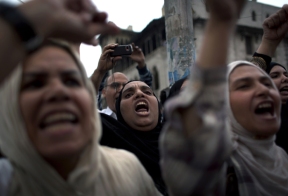Laura Farrington
Blog Post #1
For this semester, my group was given the area “Middle East/ North Africa”. Of all the countries to choose from, I thought Egypt would be the most interesting to learn about, in many aspects, such as politics and economy, as well as culture and lifestyle. Egypt is not a country I have much previous knowledge about, so I look forward to learning about many different parts of Egypt throughout the semester.
The geographical location of Egypt is in the north East part of Africa, with Libya to the west, Sudan to the south, and Israel, Jordan, and Saudi Arabia to the east. According to World Meters website, the current population of Egypt is around 82 million, equivalent to 1.25% of the world’s population. The location of Egypt makes its ecosystem is a hot, desert style environment. This creates some environmental issues for the country, including desertification, as well as loss of cropland to urbanization. Desertification is the loss of major bodies of water, as well as the little vegetation the country has. This creates many issues, as farming and crops are the main sources of income for much of Egypt, specifically the more rural areas. Urbanization destroys usable cropland, and encroaches on farmers lands, displacing them from their homes and sources of income.
According to the CIA website, Egypt is currently run in a republic type government system. In this type of government, power sits with elected officials who represent the citizens of the country, and they use the rule of law to dictate how their decisions are made. This is similar to that of the United States, where there is a president and an elected cabinet of officials in an executive, legislative, and judicial branch. The current president of Egypt is Abdel Fattah el-Sisi. He was elected back in 2014 , two years after the former president was deposed by the Egyptian Army in 2013, and three years after dictator type president, Hosni Mubarak was removed from office. The former president, Mohamed Morsi, was overthrown because of his involvement with killings of opponents outside his palace, as well as with espionage for foreign militant groups. Among these things, Morsi was closely related with extremist groups, which engage in and encourage violence against state institutions.

Currently, in Egypt, the most recent nation wide event was on January 25th, 2016. This was the fifth anniversary of the 2011 revolution that turned around the government system by removing Mubarak from office. After this revolution, a new constitution was drafted, as well as new parliamentary and presidential elections scheduled. In November 2012, the new constitution was drawn up, but once the population of Egypt got word of the ideas it entailed, they protested rapidly in 2013, including violent protests that caused some civilian deaths. In July 2013, the military removed Morsi from office, as well as suspended the constitution he created the year before. President Sisi was then elected shortly after, which the Egyptian people supported. This new president created more issues with the Muslim Brotherhood, sending them into violent protests and backlash.
Since this time, Egypt has gone through ups and downs of protest, and times of a copacetic government. Currently Egypt is in a more peaceful, more developmental state. The United States still provides monetary aid to Egypt, about 1.3 million in aid, although the United States government does not always support what the Egyptian government does. Their economy and government is on the rise, while their environmental issues still need some work.
http://www.worldometers.info/world-population/egypt-population/
http://www.heritage.org/index/country/egypt
http://www.pbs.org/wgbh/frontline/article/timeline-whats-happened-since-egypts-revolution/